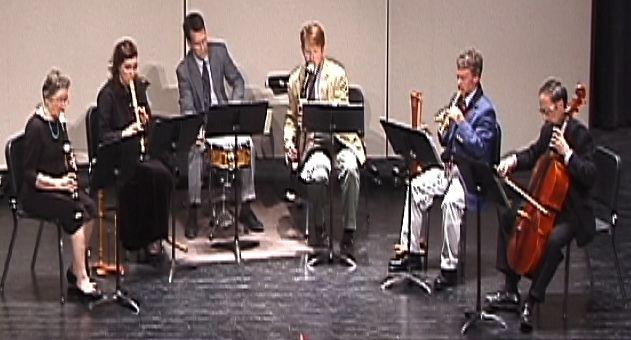

Founded by Dr. Johnson in the spring of 2004, this faculty-community ensemble performs both on and off campus for classes, demonstrations, and recitals. The consort includes faculty and community members playing a variety of Renaissance and Baroque instruments such as the recorder, guitar, and cello. In addition, hand percussion instruments are also included in this ensemble. Past programs have included works by Morley, Rossi, Holborne, Susato, and Purcell.
Current members of the consort are:

(from left to right) Catherine Hume, recorders, Sara Westermark, lyric soprano and recorders,
John Rack, percussion, Daniel Johnson, recorders, Bob Russell, recorders, and Richard Thomas, violonello
Video examples from a recent recital:
Note: Real Media Player is needed to view these video clips. Click here to download your FREE Real Media Player.
 "Gagliard" is a very popular piece in the court of England in the late 15th and early 16th centuries. This Gagliard was written by Anthony Holborne (1584 - 1602) who scored more than 150 works for lute, bandora, citterns, and recorder consorts, as seen here. The Gagliard is a livey triple-meter court dance, probably orignating in Norhern Italy.
"Gagliard" is a very popular piece in the court of England in the late 15th and early 16th centuries. This Gagliard was written by Anthony Holborne (1584 - 1602) who scored more than 150 works for lute, bandora, citterns, and recorder consorts, as seen here. The Gagliard is a livey triple-meter court dance, probably orignating in Norhern Italy.
 "Bransle" is a dance form popular in France for many centuries and is the ancestor to the Minuet. This Bransle was written by Estienne du Tertre, a 16th century French composer, who also served as an editor, composer, and arranger of numerous chansons, pavanes, gagliards, and bransles.
"Bransle" is a dance form popular in France for many centuries and is the ancestor to the Minuet. This Bransle was written by Estienne du Tertre, a 16th century French composer, who also served as an editor, composer, and arranger of numerous chansons, pavanes, gagliards, and bransles.
 "Andante" is the first of a set of five movements by Salomone Rossi, a sixteenth-century composer from Northern Italy. Rossi published five books of madrigals, chamber duets, three part canzonettas and sinfonie such as the piece offered here.
"Andante" is the first of a set of five movements by Salomone Rossi, a sixteenth-century composer from Northern Italy. Rossi published five books of madrigals, chamber duets, three part canzonettas and sinfonie such as the piece offered here.
Audio examples from a recent recital:
 "Conuerte Nos," a sixteenth-century duet for soprano and tenor recorders composed by Laurentus Lemin. Aside from a few charming pieces such as this duet, little is known of Lemin's life and musical background.
"Conuerte Nos," a sixteenth-century duet for soprano and tenor recorders composed by Laurentus Lemin. Aside from a few charming pieces such as this duet, little is known of Lemin's life and musical background.
 "Air" from The Faerie Queen by Henry Purcell is a sprightly movement for recorders, cello, and percussion. This piece was first performed in 1692 as part of this "semi-opera."
"Air" from The Faerie Queen by Henry Purcell is a sprightly movement for recorders, cello, and percussion. This piece was first performed in 1692 as part of this "semi-opera."
 "Greensleeves" is today the best known and most popular melody from fifteenth to seventeenth century England. It was so popular at the court of Henry VIII that it was rumored to have been composed by the king himself. Actually, the composer and date of this piece are unknown; it may have been written even earlier than the fifteenth century. Over time it has served as a drinking song, a toast to the king by the Royalists during the English Civil War, and eventually, a nineteenth century Christmas carol. This melody is scored here for recorders, cello, and percussion by Bergmann.
"Greensleeves" is today the best known and most popular melody from fifteenth to seventeenth century England. It was so popular at the court of Henry VIII that it was rumored to have been composed by the king himself. Actually, the composer and date of this piece are unknown; it may have been written even earlier than the fifteenth century. Over time it has served as a drinking song, a toast to the king by the Royalists during the English Civil War, and eventually, a nineteenth century Christmas carol. This melody is scored here for recorders, cello, and percussion by Bergmann.
